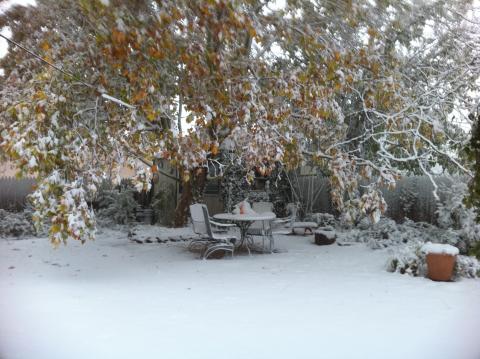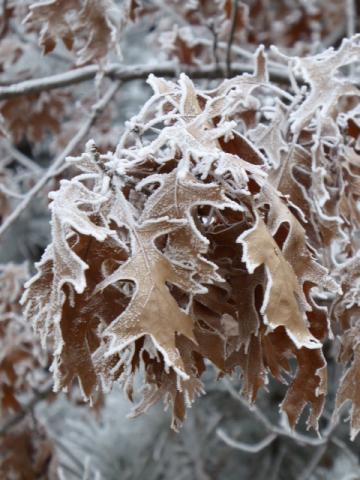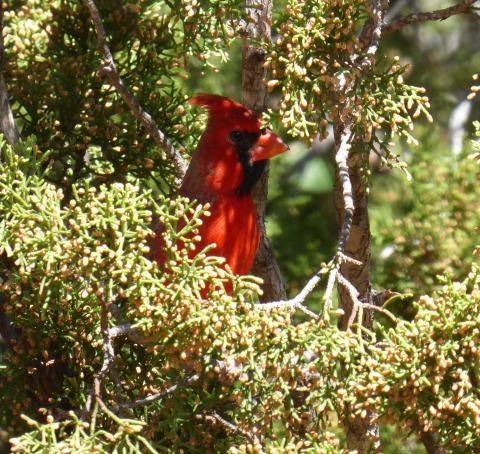
High Plains Gardening
The gardening website of the Texas High Plains Region
The first freeze of the fall may have already occurred, or not. Regardless, temperatures are much cooler as the daylight shortens. Flowers blooming in Ocotber will continue to do so right into November until a cold enough freeze. You will notice some flowers continue to bloom even after the first frost, unless it was quite severe. In most of the past several years, the first hard freeze didn't arrive until sometime in November, bestowing on the gardener additional days and weeks of bloom. I'm always hoping there will be a some flowers to cut for a bouquet during Thanksgiving and Christmas. Regardless of the first snows, there is usually enough dried and evergreen material to make a dried fall bouquet that can be quite beautiful. Evergreens are traditional for the holidays. Planting a few boxwoods, at least, will allow one to take a few snips to add greenry to a vase. Geraniums (Pelargoniums) stored inside will continue to flower (even into the end of winter and beginning of spring, when kept in a warm, sunny exposure).
As the weather turns colder in December, a few broadleaf evergreen plants will exhibit winter-red. Walking through the neighborhoods or botanical gardens, these will be evident. Some hardy geraniums, heucheras, penstemons, eriogonums, even honeysuckle, will display winter-red. Once a fall snowfall occurs, a quiet peace envelopes the landscape. The garden and landscape falls outwardly into a state of rest and recuperation. These two months provide rest, a refreshing and a renewal of spirit and enthusiasm for the gardener as the holiday season takes precedence.
Stepping Stones is arranged in most cases on a week to week basis within the months with gardening tasks described by order of the Seven Principles of Gardening, as needed, namely:
1. Plan and Design
2. Analyze and Improve the Soil
3. Create Practical Turf Areas
4, Choose Appropriate Plants
5. Efficient Use of Water
6. Use Organic or Inorganic Mulch
7. Practice Appropriate Maintenance
Following the weeks' tasks, I've included suggestions under the headings "Keep it Up", "Extras", "Be a Plant Explorer" and "Oops! and/or Don't" -- extra tips I practice and have found to be important or interesting. If you've been gardening for several years, there will be fewer tasks each week for each principle. Included in the sidebar at the right are QuickSteps -- a summary or outline of tasks to do each month. Feel free to copy and print out to refer to during the month.
Don't worry if you can't get to the task in the first week suggested. These times are when I've noticed the earliest most likely success achievable. Naturally, each and every year will be different. Some years will be warmer, some cooler. Adjust and stay tuned to the weather.
Plan and Design
Bare of most foliage, the winter landscape offers to us the opportunity of evaluating the structural merits of the landscape. With the passing of the seasons colorful fanfare, we are able to better see areas within the garden framework that require improvement. Is our garden one dimensional, a flat plane of annuals with little structural interest? Is there a framework from which to build plant compositions or communities that provide not only a plant ecology in harmony with nature, but also visual interest? At the same time you consider the structure of the garden, evaluate your landscape for winter plant interest.
Adding rocks or boulders, shrubs and trees can make simple improvements to visual interest and habitats. Paths, walls, arbors, pergolas, lattices, statuary, benches are some of the more common hardscape features that provide bones for the garden structure. The intrusion of adding structural elements to the landscape into and around beds and borders is less damaging after plants have gone to ground. (Photo of a xeric garden during the first week of November at uppper left.)
During the season of giving, put a garden feature on your wish list. Statuary, benches, containers, sculpture, garden tools, equipment and books will be appreciated by most of your gardener friends and family.
Amend the Soil
Preparation of spring beds can begin in early November using the smothering or lasagna method. Regardless of the method, beginning bed preparation in the fall allows for the soil food web to begin activation months ahead of planting.
Turf
Avoid the spring rush; the end of the mowing season is a great time to sharpen the blades on the lawn mower and provide routine maintenance on power tools.
Appropriate Plants
November and December are excellent months to plant trees and shrubs.
Garlic, shallots and onions could be planted now if you can find them for sale. I keep back cloves of garlic from the summer harvest and normally plant them in November. Some gardeners immediately plant the largest cloves around the time they harvest the garlic. I haven't found much difference between the two methods.
 Plant spring bulbs before January. November is my month of choice out of preference, not necessity. After the excesses of Thanksgiving dinner, I enjoy a few hours in the garden, even if the weather is bracing. Planting anytime between October and December 31st, should yield good results. Late winter or early spring blooming bulbs may experience delayed bloom the first year if planted in late December or later.
Plant spring bulbs before January. November is my month of choice out of preference, not necessity. After the excesses of Thanksgiving dinner, I enjoy a few hours in the garden, even if the weather is bracing. Planting anytime between October and December 31st, should yield good results. Late winter or early spring blooming bulbs may experience delayed bloom the first year if planted in late December or later.
If you’ve dug up Amaryllis bulbs to force blooms, remember to rescue them from darkness. After about 8 weeks, pot them, and keep lightly moist in a bright, sunny inside location, above 55º. They will begin to re-bloom during the holiday season. (Garden Design Magazine, Dec. 2000-Jan. 2001).
Dig up any non-cold hardy bulbs to store indoors if you haven’t already.
Efficient Use of Water
Remember to water throughout the winter, but turn off the automatic system. ET rates are greatly lessened; adjust watering accordingly. Especially, do not neglect watering fall planted trees and shrubs.
Continue to water the winter annuals (pansies, ornamental cabbage, etc.) on a regular basis.
Perform fall maintenance on drip and other irrigation systems. Flush out the lines and clean the filters. Drain hoses for winter. Disconnect shut off valves and timers to avoid breakage due to freezing. Check piping for holes and cuts.
Mulch
Finish any fall tasks of mulch replenishment. Add additional mulch or cut evergreen boughs to place over Zone 7 (and higher) plants you are testing for cold hardiness.
Maintenance
Choose a calcium chloride de-icer (instead of a sodium based de-icer) for those snowy, icy driveways and sidewalks. Use only in the recommended manner to minimize residue in your lawn and gardens.
Don’t neglect our feathered friends, if you’ve supplied them with food and water, continue to do so; they’re expecting it.

A little tidying up in the garden is OK, but keep it to the minimum. Beneficial insects, including bees, nest in the dried stems of plants and leaf litter. Wild or unkempt areas are desired by wildlife. Birds rely on seeds from perennials to make it through the winter. Studies have shown that gardens are more resilient during winter when cleanup is delayed until late winter (end of February) and early spring.
All but the most southern gardens within a day’s drive of the Texas Panhandle have entered the winter rest. Most major botanic gardens celebrate the winter season with a festival of lights, from San Antonio, to Dallas, Oklahoma City, Albuquerque, El Paso, Tucson, Phoenix and Denver, inviting the public to enjoy lights, music, and special events. Visit the gardens just prior to dusk for examples of the structural merits of their gardens, and pick up professional design tips to use in your own garden. Don't forget to volunteer and visit the Christmas Lights in the Gardens at the Amarillo Botanical Gardens.
After shaking out the snow, relax at the fireplace, hot cocoa in hand. Warm and cozy, it’s a perfect setting for perusing old issues of garden magazines. Like most hard-core gardeners, I have kept all my back issues. Each time I flip back through them, I discover articles passed over, or information long forgotten. Many times the articles I’ve read had sparked an interest in a design feature or new plant group. Revisiting the magazines triggers pleasant memories of the garden throughout the years.
Revised, February, 2018 